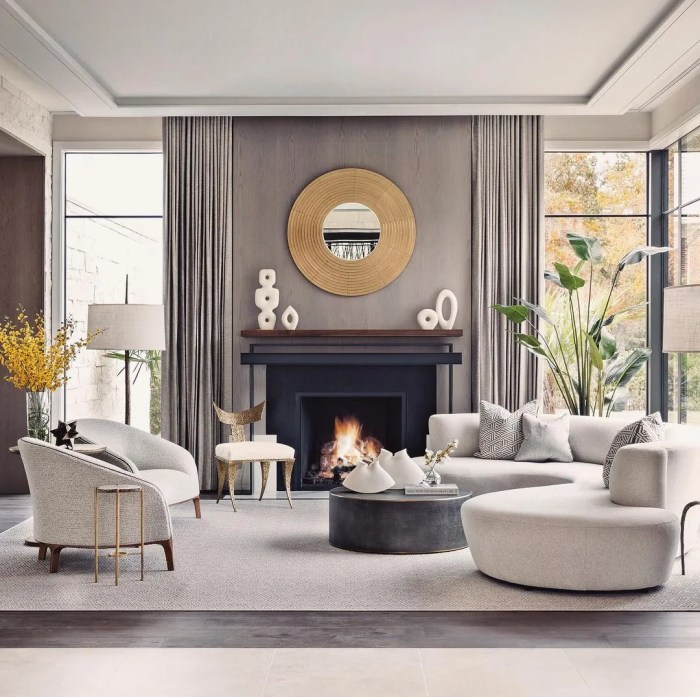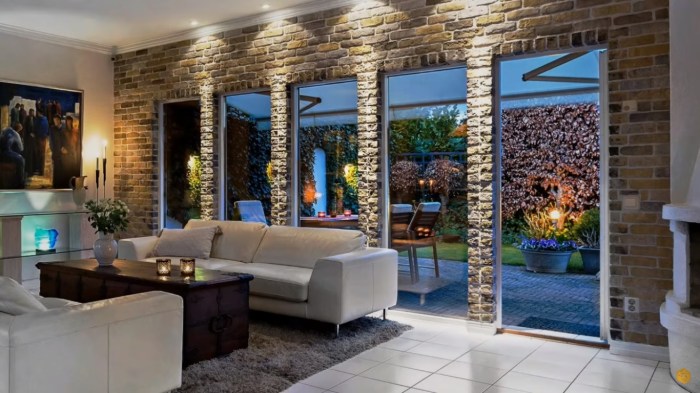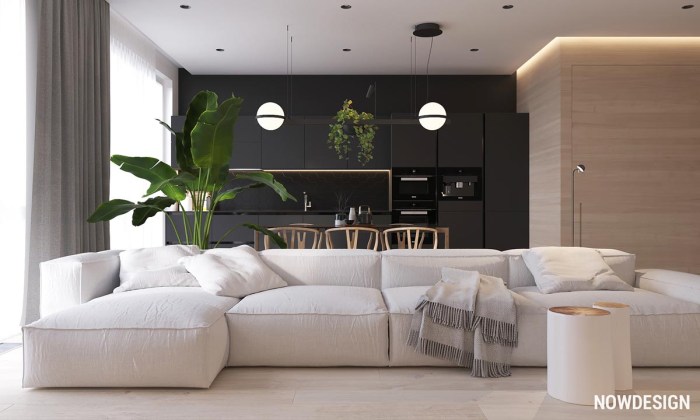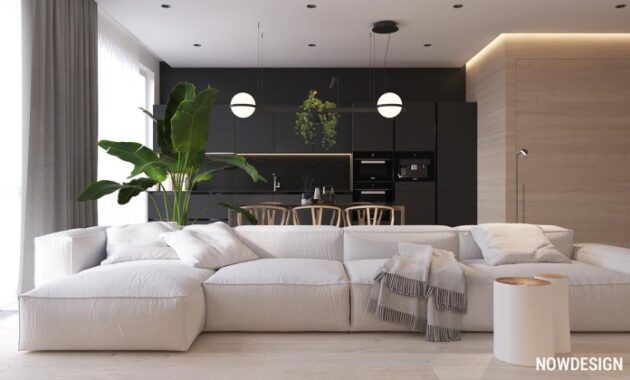Aesthetic interior house design is more than just making a space look good; it’s about creating an environment that feels harmonious, inspiring, and reflects your personal style. It’s about understanding the interplay of colors, textures, furniture, and lighting to create a cohesive and inviting atmosphere.
This guide delves into the principles and practices of aesthetic interior design, exploring how to transform your house into a haven of beauty and functionality.
From understanding different aesthetic styles to choosing the right furniture and decorative elements, we’ll cover the key aspects of creating a visually appealing and emotionally resonant home. We’ll also explore the growing importance of sustainable and ethical design practices, ensuring your home is not only beautiful but also responsible.
Aesthetic Interior Design for Different Rooms: Aesthetic Interior House Design

Aesthetic interior design is an art form that blends functionality with visual appeal, creating spaces that are both comfortable and inspiring. Each room in a home presents unique opportunities for creating a distinct aesthetic, catering to specific functions and personal preferences.
Living Room Aesthetics
The living room is the heart of the home, a space for gathering, relaxation, and entertainment. A thoughtfully designed living room aesthetic should prioritize comfort, functionality, and visual appeal.
- Color Palette:Neutral tones like beige, gray, and white provide a calming backdrop, while pops of color through accent pieces like throw pillows, artwork, or rugs can inject personality and vibrancy. Consider using a color wheel to select complementary or contrasting colors that create visual interest.
- Furniture:Comfortable seating is essential, and a balanced arrangement of sofas, armchairs, and coffee tables encourages conversation and relaxation. The furniture should be functional, aesthetically pleasing, and complement the overall style of the room.
- Lighting:Layered lighting, combining overhead lighting with lamps and accent lighting, creates a warm and inviting ambiance. Consider using dimmer switches to adjust the lighting intensity for different moods.
- Decorative Elements:Artwork, sculptures, plants, and decorative accessories add personality and visual interest to the living room. Choose items that reflect your personal style and complement the overall design theme.
Bedroom Aesthetic
The bedroom is a sanctuary for rest and rejuvenation, where a calming and serene aesthetic is paramount.
- Color Palette:Soft, muted tones like pale blues, greens, and grays promote relaxation and tranquility. Avoid overly bright or stimulating colors that might interfere with sleep.
- Bed:The bed is the focal point of the bedroom, and a comfortable and stylish bed frame is essential. High-quality bedding in soft, natural fabrics adds to the luxurious feel.
- Lighting:Soft, warm lighting creates a relaxing atmosphere. Consider using bedside lamps with adjustable brightness for reading or relaxing.
- Storage:Organized storage is crucial for maintaining a calm and clutter-free environment. Use bedside tables, dressers, or wardrobes to keep belongings neatly tucked away.
- Decorative Elements:Artwork, plants, and soft textiles like throw pillows and blankets can add personality and warmth to the bedroom. Choose items that promote a sense of peace and serenity.
Kitchen Aesthetics
The kitchen is a hub of activity, where functionality and aesthetics go hand in hand. A well-designed kitchen should be both efficient and visually appealing.
- Layout:The layout of the kitchen should facilitate smooth workflow and ease of movement. Consider the “work triangle” principle, which positions the sink, stove, and refrigerator in a triangular configuration for optimal efficiency.
- Cabinetry:Cabinets are a major design element in the kitchen, and they should be both functional and stylish. Choose materials like wood, laminate, or painted finishes that complement the overall aesthetic.
- Countertops:Durable and stylish countertops are essential for food preparation and display. Options include granite, quartz, marble, or butcher block.
- Backsplash:A backsplash protects the walls and adds a decorative touch. Choose a material and design that complements the countertops and cabinetry.
- Lighting:Adequate lighting is essential for food preparation and task lighting. Consider using a combination of overhead lighting, under-cabinet lighting, and pendant lights over the island or dining area.
- Decorative Elements:Plants, artwork, and decorative accessories can add warmth and personality to the kitchen. Choose items that reflect your personal style and complement the overall design theme.
Bathroom Aesthetics
The bathroom is a space for relaxation and rejuvenation, where a spa-like aesthetic can be achieved through careful design choices.
- Color Palette:Neutral colors like white, beige, and gray create a clean and calming atmosphere. Consider adding pops of color through towels, rugs, or accessories.
- Lighting:Soft, warm lighting creates a relaxing ambiance. Consider using dimmable lights and incorporating natural light through windows.
- Fixtures:Sleek and modern fixtures like faucets, showerheads, and towel bars add a touch of luxury and sophistication. Choose materials like chrome, brushed nickel, or stainless steel.
- Storage:Organized storage is essential for maintaining a clean and clutter-free bathroom. Use cabinets, shelves, and drawers to keep toiletries and other items neatly tucked away.
- Decorative Elements:Plants, artwork, candles, and decorative accessories can add a touch of personality and relaxation to the bathroom. Choose items that promote a sense of tranquility and well-being.
Sustainable and Ethical Interior Design
The field of interior design is undergoing a significant transformation, driven by a growing awareness of environmental and social responsibility. Sustainable and ethical practices are becoming increasingly crucial, as consumers demand designs that are both aesthetically pleasing and environmentally conscious.
Sustainable Materials
The use of sustainable and eco-friendly materials is at the forefront of this movement. These materials are sourced and manufactured in ways that minimize their impact on the environment. For example, using recycled materials like reclaimed wood or repurposed glass not only reduces waste but also adds a unique character to interior spaces.
Sustainable options like bamboo, cork, and natural fibers are also gaining popularity, as they are renewable and biodegradable.
Incorporating Recycled and Repurposed Materials
- Reclaimed Wood:Reclaimed wood, salvaged from old buildings or structures, offers a rustic charm and reduces the need for new lumber. It can be used for flooring, furniture, or even accent walls.
- Repurposed Glass:Glass bottles and jars can be transformed into beautiful decorative elements, such as vases, candle holders, or even mosaic tiles. This creative reuse adds a touch of whimsy and sustainability to any space.
- Upcycled Furniture:Old furniture can be given a new life with a fresh coat of paint, new upholstery, or creative modifications. This practice reduces waste and adds a unique touch to your home.
Minimizing Waste and Promoting Responsible Consumption
- Shop Locally:By supporting local artisans and manufacturers, you can reduce the environmental impact of transportation and support sustainable practices.
- Choose Durable Materials:Investing in durable and long-lasting furniture and materials reduces the need for frequent replacements and minimizes waste.
- Reduce, Reuse, Recycle:This mantra applies to interior design as well. Consider repurposing existing furniture, using second-hand items, and recycling materials whenever possible.
Ethical Sourcing
Ethical sourcing is an essential aspect of sustainable interior design. It involves ensuring that materials and furniture are produced in a way that respects workers’ rights, promotes fair labor practices, and avoids harmful environmental impacts.
Inspiration and Resources

Aesthetic interior design is a constantly evolving field, driven by creativity and a deep understanding of style. To stay ahead of the curve and find inspiration for your own projects, it’s crucial to tap into a diverse range of resources.
Popular Interior Design Magazines and Websites
Interior design magazines and websites are excellent sources of inspiration, showcasing the latest trends, innovative ideas, and breathtaking projects. These platforms offer a glimpse into the world of professional designers, providing valuable insights into color palettes, furniture selections, and overall design aesthetics.
- Architectural Digest:Known for its high-end and luxurious designs, Architectural Digest features stunning homes, showcasing the work of renowned architects and designers. Its articles delve into the creative process behind each project, offering a behind-the-scenes look at the world of high-end design.
- Elle Decor:With a focus on contemporary and modern aesthetics, Elle Decor presents a blend of sophisticated and stylish designs. Its articles explore a wide range of design styles, from minimalist to maximalist, providing inspiration for diverse tastes.
- House Beautiful:This magazine caters to a broader audience, offering a mix of traditional and modern design styles. House Beautiful features practical design tips, DIY projects, and inspiring home tours, making it a valuable resource for both seasoned and aspiring homeowners.
- Dwell:Dwell focuses on modern and sustainable design, featuring homes that prioritize functionality and environmental consciousness. Its articles explore innovative materials, eco-friendly practices, and the latest trends in sustainable design.
- Remodelista:This website is a curated resource for design enthusiasts, featuring a collection of stylish and functional home decor and design ideas. Remodelista showcases both contemporary and classic designs, with a focus on quality and craftsmanship.
Influential Interior Designers and Their Signature Styles
Many influential interior designers have left their mark on the world of design, shaping trends and inspiring generations of aspiring professionals. Each designer brings a unique perspective and signature style, making them invaluable sources of inspiration.
- Kelly Wearstler:Known for her bold and eclectic designs, Kelly Wearstler seamlessly blends modern and traditional elements, creating spaces that are both luxurious and inviting. Her signature style often features rich textures, vibrant colors, and a mix of vintage and contemporary pieces.
- Jonathan Adler:With a focus on playful and sophisticated designs, Jonathan Adler’s work often incorporates bold colors, geometric patterns, and a touch of whimsy. His signature style is characterized by its vibrant energy and eclectic mix of textures and materials.
- Nate Berkus:Nate Berkus is known for his approachable and timeless designs, creating spaces that are both stylish and comfortable. His signature style often features neutral color palettes, natural materials, and a mix of vintage and modern pieces, creating a sense of warmth and welcoming.
- Sarah Sherman Samuel:Sarah Sherman Samuel’s designs are characterized by their bright and airy aesthetic, often incorporating a mix of modern and traditional elements. Her signature style features light and airy color palettes, natural textures, and a focus on creating inviting and functional spaces.
Aesthetic interior house design goes beyond just choosing pretty furniture and colors. It’s about creating a space that reflects your personality and enhances your lifestyle. For larger families or those seeking more space, a 2 storey house design interior offers endless possibilities for creating distinct zones for different activities.
Whether you’re aiming for a minimalist haven or a vibrant, eclectic style, the right interior design can transform your house into a home that truly feels like you.
- Paloma Contreras:Paloma Contreras’s designs are known for their elegant and sophisticated aesthetic, often incorporating a mix of traditional and contemporary elements. Her signature style features a blend of rich textures, vibrant colors, and a focus on creating timeless and inviting spaces.
Resources for Finding Unique Furniture Pieces and Decorative Elements
Finding unique furniture pieces and decorative elements is essential for creating a truly personalized and stylish space. Explore these resources to discover hidden gems and elevate your interior design project.
Aesthetic interior house design is a personal journey, reflecting your unique style and tastes. If you’re drawn to the elegance and glamour of a bygone era, you might find inspiration in the 1920s house interior design style, with its Art Deco motifs, geometric patterns, and luxurious materials.
Ultimately, the goal is to create a space that feels both beautiful and comfortable, a sanctuary that reflects your individual personality.
- Etsy:This online marketplace is a treasure trove of handcrafted and vintage furniture pieces, offering a wide range of styles and unique finds. Etsy is a great resource for supporting independent artisans and discovering one-of-a-kind pieces.
- Chairish:This website specializes in curated vintage and antique furniture, offering a wide selection of styles and periods. Chairish is a great resource for finding unique and high-quality pieces that add character and history to your home.
- 1stDibs:This online marketplace features a vast collection of high-end antiques, vintage furniture, and decorative objects, offering a curated selection of unique and rare pieces. 1stDibs is a great resource for those seeking investment-worthy pieces and statement items.
- Local Antique Shops and Flea Markets:Visiting local antique shops and flea markets is a great way to discover hidden treasures and unique pieces. These venues often offer a diverse range of items, from vintage furniture to antique decor, providing a chance to find one-of-a-kind pieces that reflect your personal style.
- Designers Guild:This website offers a curated selection of high-end furniture, fabrics, and decorative accessories, showcasing a range of styles and designs. Designers Guild is a great resource for those seeking quality and craftsmanship, with a focus on creating luxurious and stylish spaces.
Online Platforms for Finding Inspiration and Resources
The internet is a vast and valuable resource for interior design inspiration and resources. Explore these online platforms to discover a world of ideas, trends, and practical advice.
| Platform | Focus | Key Features |
|---|---|---|
| Visual inspiration | Image-based platform for discovering and saving ideas, organizing them into boards, and finding inspiration across a wide range of topics, including interior design. | |
| Houzz | Home design and renovation | Platform for connecting homeowners with professionals, finding inspiration for home design and renovation projects, and exploring a vast library of images and ideas. |
| Visual inspiration and community | Photo-sharing platform for connecting with designers, discovering trends, and finding inspiration through user-generated content. | |
| YouTube | Video tutorials and inspiration | Video-sharing platform for finding tutorials, behind-the-scenes looks at design projects, and inspiration from designers and DIY enthusiasts. |
| Design blogs | Expert insights and trends | Blogs written by designers, architects, and design enthusiasts, offering insights into the latest trends, design tips, and project inspiration. |
The Impact of Aesthetic Interior Design

Aesthetic interior design goes beyond just making a space look good; it has a profound impact on our psychological and emotional well-being. A thoughtfully designed interior can influence our moods, behaviors, and even our productivity.
The Psychological and Emotional Impact of Aesthetic Interior Design
A well-designed aesthetic space can positively impact our mental and emotional states. When we surround ourselves with beauty and harmony, we create an environment that fosters feelings of calm, joy, and inspiration. This can be particularly beneficial in our increasingly busy and stressful lives.
How Aesthetic Design Enhances Well-being and Productivity, Aesthetic interior house design
Aesthetic design can significantly contribute to our overall well-being and productivity.
- Reduced Stress and Anxiety:A calming and visually appealing environment can help reduce stress and anxiety levels. Studies have shown that exposure to nature, natural light, and calming colors can lower cortisol levels, the stress hormone.
- Increased Focus and Concentration:A well-organized and clutter-free space can promote focus and concentration. The absence of visual distractions allows us to better engage in tasks and achieve a sense of accomplishment.
- Enhanced Creativity and Inspiration:Surrounding ourselves with inspiring art, colors, and textures can stimulate our creativity and imagination. This can be particularly helpful in environments where innovation and problem-solving are crucial.
- Improved Sleep Quality:A bedroom designed with calming colors, soft lighting, and comfortable furniture can contribute to better sleep quality. A restful sleep environment is essential for physical and mental rejuvenation.
Examples of Aesthetic Design Creating Calm, Joy, and Inspiration
- Minimalist Design:Characterized by clean lines, neutral colors, and a focus on functionality, minimalist design promotes a sense of calm and order. It creates a sense of spaciousness and reduces visual clutter, allowing us to relax and recharge.
- Biophilic Design:This design approach incorporates elements of nature, such as plants, natural light, and organic materials. Biophilic design has been shown to reduce stress, improve mood, and increase productivity.
- Art Deco Design:Known for its geometric patterns, rich colors, and luxurious materials, Art Deco design can evoke a sense of sophistication, glamour, and excitement. It can create a vibrant and stimulating environment, perfect for social gatherings or creative endeavors.
Aesthetic Design Influencing Mood and Behavior
Aesthetic design has the power to influence our moods and behaviors. The colors we choose, the textures we incorporate, and the overall ambiance we create can significantly impact our emotional state and how we interact with our surroundings.
- Color Psychology:Different colors evoke different emotions. For example, blue is often associated with calmness and tranquility, while red is associated with energy and excitement. Understanding color psychology can help us create spaces that support our desired mood and behavior.
- Lighting:Lighting plays a crucial role in setting the mood and ambiance of a space. Warm, soft lighting can create a cozy and inviting atmosphere, while bright, cool lighting can promote alertness and focus.
- Furniture and Accessories:The furniture and accessories we choose can also influence our mood and behavior. Comfortable seating can encourage relaxation, while functional storage solutions can promote organization and efficiency.
Summary
By embracing the principles of aesthetic interior house design, you can create a space that not only looks stunning but also enhances your well-being and productivity. Whether you’re a design enthusiast or just starting to explore the world of home decor, this guide provides a comprehensive framework for transforming your house into a haven of beauty, comfort, and inspiration.
So, let your creativity flow and embark on a journey of creating a home that truly reflects your unique style and personality.
User Queries
What are some common aesthetic interior design styles?
Popular styles include minimalist, bohemian, modern, traditional, Scandinavian, industrial, and farmhouse.
How can I create a cohesive aesthetic throughout my house?
Maintain a consistent color palette, use similar furniture styles, and incorporate recurring patterns and textures throughout different rooms.
What are some tips for choosing the right furniture for my aesthetic?
Consider the scale and proportion of the furniture, its material and finish, and how it complements the overall style and color scheme of the room.

